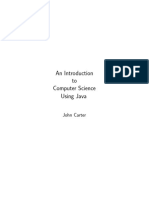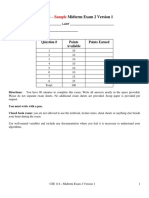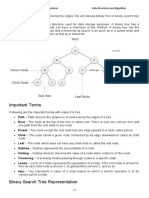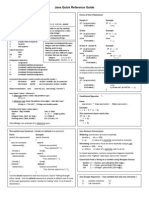Java Quick Reference Guide: String Comparisons
Uploaded by
Angela MaxwellJava Quick Reference Guide: String Comparisons
Uploaded by
Angela MaxwellJava Quick Reference Guide
Arithmetic Operators
+
Addition
Subtraction
/
Division (int / floating-point)
2/3 = 0, 2.0/3.0 =.666667
*
Multiplication
%
Modulus (integer remainder)
Relational/Equality Operators
<
Less than
<= Less than or equal to
>
Greater than
>= Greater than or equal to
== Equal to
!= Not equal to
Remember to use the methods
equals( ) or compareTo( ) when comparing
Strings rather than relational comparison
operators.
Example
if (expression)
statement;
if (x < y)
x++;
String Comparisons:
if/else
Example
Compare for equality:
s1.equals(s2) or
s1.compareTo(s2) == 0
if (expression)
statement;
else
statement;
if (x < y)
x++;
else
x--;
Remember the compareTo( ) method
returns one of 3 values:
neg number, pos number, 0
if/else if (nested if)
Example
String s1 = "abc", s2 = "def";
Remember to distinguish between integers
and real numbers (called floating-point in
Java). These are stored differently in
memory and have different ranges of
values that may be stored.
Assignment Operators
=
simple assignment
+= addition/assignment
-= subtraction/assignment
*= multiplication/assignment
/= division/assignment
%= modulus/assignment
integer:
floating-point:
2, 3, -5, 0, 8
2.0, 0.5, -3., 4.653
Increment ++ /Decrement -- operators used in prefix and postfix modes
++/-prefix mode - inc(dec) variable, use variable in the larger expression
++/-postfix mode - use variable in larger expression, inc(dec) variable
Object Creation: ( new )
new int[ 10 ], new GradeBook("CIS 182")
The new operator creates an object and returns a reference (address of an object)
Java Types [value/reference ]
A value type stores a value of a primitive type
int x = 3;
A reference type stores the address of an object
Circle c = new Circle(2);
A reference variable is created using a class name: GradeBook myGradeBook;
Primitive Data Types ( Java value types ) Remember: String is a reference type
boolean
flag / logical
true, false
[ boolean literals ]
char
character
'A', 'n', '!'
[ char literals ]
byte, short, int, long
integral
2, 3, 5000, 0 [ int literals ]
float, double
floating-point
123.456, .93 [ double literals ]
Default numeric literal types:
integral:
int
floating-point:
double
Forms of the if Statement
Simple if
Compare for lexical order:
s1.compareTo(s2) < 0 (s1 before s2)
s1.compareTo(s2) > 0 (s1 after s2)
Logical Operators
!
NOT
&& AND
|| OR
Last Update: Monday, July 21, 2014
int x = 3;
double y = 2.5;
//3 is an int literal
//2.5 is a double literal
Most commonly used reference type in Java is String. String name = "Jack";
The switch/case Construct ( break and default are optional )
if (expression)
statement;
else
if (expression)
statement;
else
statement;
if (x < y)
x++;
else
if (x < z)
x--;
else
y++;
The
"expression" in
the parentheses
for an
if statement
or
loop
is often also
referred to as a
"condition"
To conditionally execute more than one statement, you must
create a compound statement (block) by enclosing the statements
in braces ( this is true for loops as well ):
Form
Example
if (expression)
{
statement;
statement;
}
if (x < y)
{
x++;
System.out.println( x );
}
Input using Scanner class
Scanner input = new Scanner ( System.in ); //keyboard input
input methods: next(), nextLine(), nextInt(), nextDouble()
Output methods for System.out or PrintWriter objects
print(), println(), printf() [formatted output]
Input/Output using JOptionPane class [ package javax.swing ]
String numString; int num;
numString = JOptionPane.showInputDialog("Enter a number");
num = Integer.parseInt(numString);
JOptionPane.showMessageDialog(null, "Number is " + num);
Conversion from a String to a number using Wrapper Classes
double d = Double.parseDouble(dString);
float f = Float.parseFloat(fString);
int
j = Integer.parseInt(jString);
Form:
switch (expression)
{
case int-constant :
statement(s);
[ break; ]
Example:
switch (choice)
{
case 0 :
System.out.println( You selected 0. );
break;
case int-constant :
statement(s);
[ break; ]
case 1:
System.out.println( You selected 1. );
break;
Format-specifiers: s (string), d (integer), f (floating-point)
Example: System.out.printf("Total is %,10.2f\n", total);
[ default :
statement; ]
default :
System.out.println(
You did not select 0 or 1. );
Java Numeric Conversions and Casts:
The "expression" and int-constant are usually type int or char. Java 7
adds the ability to use a string. switch(behavior) { case good: }
Use the break keyword to exit the structure (avoid falling through other
cases). Use the default keyword to provide a default case if none of the
case expressions match (similar to trailing else in an if-else-if
statement).
Java formatted output [ printf( ) and String.format( ) methods ]
3 components: format string and optionally: format-specifiers ( fs )
and an argument list ( al )
fs: " ... % [flags] [width] [precision] format-specifier ... "
al: comma separated list of expressions
Widening conversions are done implicitly.
double x; int y = 100;
x = y;
// value of y implicitly converted to a double.
Narrowing conversions must be done explicitly using a cast.
double x = 100; int y;
y = (int) x; // value of x explicitly cast to an int
In mixed expressions, numeric conversion happens implicitly.
double is the highest primitive data type, byte is the lowest.
Java Quick Reference Guide
Last Update: Monday, July 21, 2014
The while Loop ( pre-test loop )
The for Loop ( pre-test loop )
Form:
Example:
Form:
Example:
x = 0;
while (x < 10)
{
sum += x;
x++;
}
for (init; test; update)
{
statement;
}
for (int count=1; count<=10; count++)
{
System.out.println( count );
Enhanced for loop:
for (parameter : collection)
init;
while (test)
{
statement;
update;
}
}
statement;
int scores[ ] = {85, 92, 76, 66, 94}; //collection is the array scores
for ( int number : scores )
//parameter is the variable number
System.out.println(number);
The do-while Loop ( post-test loop )
Form:
Example:
init;
do
{
statement;
update;
} while (test);
x = 0;
do
{
sum += x;
x++;
} while (x < 10);
Escape Sequences
Operator Precedence
Special characters in Java
\n
\t
\"
\'
\\
newline character
tab character
double quote
single quote
backslash
'\n'
'\t'
'\"'
'\''
'\\'
( )
---------*, /, %
---------+, -
Logical operators: !, &&, ||
(1) mathematical (2) relational (3) logical
Selection and Loop Structures
Selection:
Unary or single selection
Binary or dual selection
Case structure possible when
branching on a variable
Simple selection
One condition
Compound selection
Multiple conditions joined
with AND / OR operators
Looping:
Java Pre-test loops
Test precedes loop body
while
for
Java Post-test loop
Test follows loop body
do-while
Loop Control:
3 types of expressions that
are used to control loops:
initialization ( init )
test
update
Counter-controlled loops,
aka definite loops, work with
a loop control variable (lcv)
Sentinel-controlled loops,
aka indefinite loops, work
with a sentinel value
Java Loop Early Exit:
break statement
Note: The break statement can
be used with a switch
statement or a loop in
Java. Loops may also use
a continue statement.
Java Arrays:
Create an array ( 2 ways )
1. <type> <array-name>[ ] = new <type>[size];
2. <type> <array-name>[ ] = { <initializer-list> };
//create an array of 20 elements.
int
[ mathematical ]
myArray[ ] = new int[20];
//create an array of 3 elements set to the values in the initializer list.
int
myArray[ ] = { 1, 2, 3 };
String stooges[ ] = { "Moe", "Larry", "Curly" };
//assign value of first element in myArray to the integer variable x.
int x = myArray[0];
//assign value of the last element in myArray to the integer variable y.
int y = myArray[ myArray.length-1 ];
Use the ArrayList class to
create a dynamically
resizable array.
The Arrays class has static
methods that can be used
with arrays and ArrayLists to
search, sort, copy, compare
for equality, etc.
int num[ ]; <stmts> .
Create a new initialized
array and assign to num.
num = new int[ ]{1,2,3,4,5};
All arrays have a public field named length which holds the number of elements in the array.
Given this declaration: int x[][][];
x.length
x[m].length
x[m][n].length
is the number of elements in the array in the first dimension.
is the number of elements for a specific array in the second dimension.
is the number of elements for a specific array in the third dimension.
Java Methods: <type> <method-name> ( [ <type> parameter1, [ <type parameter2, ] ] )
Methods that will not return a value will have the return type void in the method header.
void printHeadings( ) //no parameters, return type is void
{ <method body> }
void printDetailLine( String name, int number, double gpa ) //3 parameters, return type is void
{ <method body> }
Math.PI 3.141592635
int getCount( ) //no parameters, return type is int
{ <method body> }
double max( double x, double y ) //2 parameters, return type is double
{ <method body> }
When a method is called, the data is passed to the parameters (if any) using arguments
//Arguments: "Jack Wilson", 100, 3.50 passed to Parameters: name, number, gpa for Method:
printDetailLine (see method header above) : printDetailLine( "Jack Wilson", 100, 3.50);
A method may be declared with one variable length parameter. It must be the last parameter
declared. The syntax of the declaration is <type> ... <parameter-name>.
Examples: int... numbers, double ... values, String ...names
//implicit array creation
You might also like
- A-Level 14 Presentation - Compression, Encryption and HashingNo ratings yetA-Level 14 Presentation - Compression, Encryption and Hashing61 pages
- CSE114 Midterm 2 Sample Without SolutionsNo ratings yetCSE114 Midterm 2 Sample Without Solutions11 pages
- Important Terms: Chapter 5 - Graph and Tree Data Structures Data Structures and AlgorithmNo ratings yetImportant Terms: Chapter 5 - Graph and Tree Data Structures Data Structures and Algorithm20 pages
- Data Structures Using C and C++ - Y. Langsam, M. Augenstein and A. M. TenenbaumNo ratings yetData Structures Using C and C++ - Y. Langsam, M. Augenstein and A. M. Tenenbaum99 pages
- Ching and Christine - S Final Review SolutionsNo ratings yetChing and Christine - S Final Review Solutions15 pages
- C++ Quick Reference / C++ Cheatsheet: PreprocessorNo ratings yetC++ Quick Reference / C++ Cheatsheet: Preprocessor9 pages
- Python Programming PDF Myanmar PDF Files DownloadNo ratings yetPython Programming PDF Myanmar PDF Files Download6 pages
- Floating Point Representation Latest by MR SaemNo ratings yetFloating Point Representation Latest by MR Saem69 pages
- Embedded Systems IGCSE Comp Handout Free PDFNo ratings yetEmbedded Systems IGCSE Comp Handout Free PDF16 pages
- C and C++ Programs - Gauss Elimination MethodNo ratings yetC and C++ Programs - Gauss Elimination Method3 pages
- Unit 1 A Closer Look at Methods and Classes100% (2)Unit 1 A Closer Look at Methods and Classes21 pages
- 4.5 Exercise: Dragon Book Exercise AnswersNo ratings yet4.5 Exercise: Dragon Book Exercise Answers2 pages
- Java-Quick-Reference-Guide-bscs-bahria UniversityNo ratings yetJava-Quick-Reference-Guide-bscs-bahria University2 pages
- Funadamental Programming structures in JavaNo ratings yetFunadamental Programming structures in Java88 pages



























































